Shortstop is one of the most demanding positions in baseball. It requires a unique combination of quick reflexes, strong defensive skills, and the ability to cover a large area of the infield. Historically, the best shortstops have stood out for their defensive prowess. However, the role has evolved over time to include more offensive production. In recent decades, many shortstops have become offensive powerhouses, adding home runs and RBIs to their resume in addition to stellar glove work.
The evolution of the position reflects changes in the game itself. Teams have increasingly sought out well-rounded athletes capable of making an impact on both sides of the ball. From slick-fielding, light-hitting players in the early 20th century to today’s all-around stars, the best shortstops have consistently been at the heart of their teams’ success, showcasing the versatility and skill needed to excel in modern baseball.
Here are the 10 best shortstops ever, chosen by our editors. To meet the criteria for this list, the player must have played the majority of his innings at shortstop. Therefore, players like Ernie Banks – who played 839 more innings at first base – aren’t eligible.
10. Barry Larkin
Player History
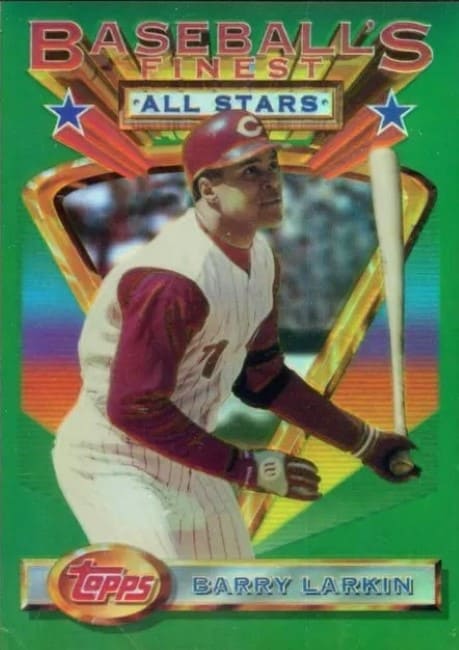
Barry Larkin spent his entire 19-year career with the Cincinnati Reds. Larkin debuted in 1986, and by the following season, he had already solidified his position as the Reds’ starting shortstop. He was known for his well-rounded game, combining solid defense, speed, and a consistent offensive presence.
Larkin’s career stats reflect his versatility. He accumulated 2,340 hits, 198 home runs, and 960 RBIs while maintaining a .295 batting average. As a base stealer, he swiped 379 bags, demonstrating his speed on the basepaths. His 1995 MVP season stands out, where he hit .319 with 51 stolen bases and 98 runs scored, showcasing his dynamic impact on both sides of the ball. Defensively, Larkin earned three Gold Glove Awards, highlighting his smooth fielding and excellent range at shortstop.
Larkin’s leadership qualities were evident as he captained the Reds for several years and was a key part of their 1990 World Series championship. He also earned 12 All-Star selections and nine Silver Slugger Awards, underscoring his prowess as an offensive force at a traditionally defense-first position.
Larkin was inducted into the Baseball Hall of Fame in 2012.
Best baseball card: 1993 Topps Finest Refractor Barry Larkin #114
1993 Topps Finest stands out as a groundbreaking set on its own, but this card also shows Barry Larkin as he was hitting his prime. The refractor parallel, with its shimmering finish and limited print run, helped introduce a new level of premium collecting – and made this Larkin card a favorite among ’90s-era enthusiasts.
Graded: $1,500-$3,000 (PSA 10)
Ungraded: $300-$400
9. Joe Cronin
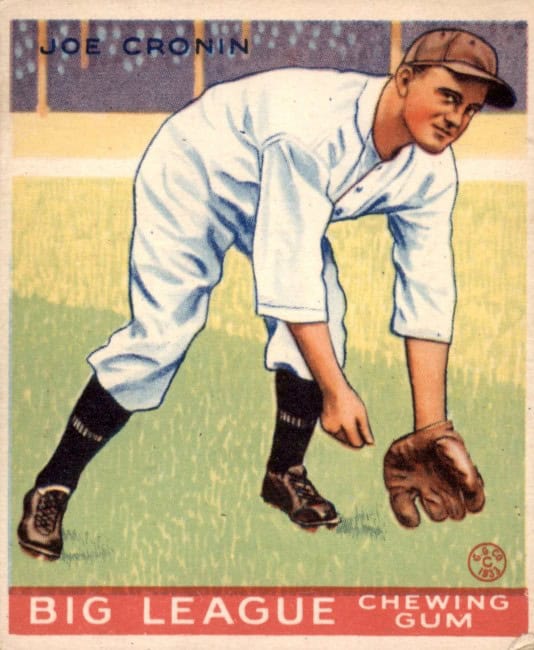
Player History
Joe Cronin was one of the most versatile shortstops of his era. He began his Major League career in 1926 with the Pittsburgh Pirates, but it was during his time with the Washington Senators and later the Boston Red Sox that he became a standout at shortstop. Known for his leadership, Cronin took over as the Senators’ player-manager in 1933 at just 26 years old. He led the team to an American League pennant that same year.
Cronin finished his career with a .301 batting average, amassing 2,285 hits, 170 home runs, and 1,424 RBIs over 20 seasons. His hitting was a rare asset for a shortstop in an era when the position was more known for defense than offense. Cronin consistently ranked among the top hitters at his position, earning seven All-Star selections throughout his career.
Defensively, Cronin was steady if unspectacular, known more for his reliability than his range. His baseball IQ and leadership on the field set him apart from many of his contemporaries, contributing to his long tenure as both a player and a manager. After retiring as a player in 1945, Cronin continued managing the Red Sox until 1947. He then transitioned into an executive role, eventually becoming president of the American League.
Joe Cronin was inducted into the Baseball Hall of Fame in 1956.
Best baseball card: 1933 Goudey Joe Cronin #189
The 1933 Goudey Joe Cronin #189 is a standout card from an iconic pre-war set. It helped usher baseball cards into the modern era. The Cronin card is also notable for its rarity and condition sensitivity. Like many of the Goudey cards from that era, the card’s red background and soft edges often result in poor centering and wear over time, making high-grade examples difficult to find.
Graded: $500-$800 (PSA 6-7)
Ungraded: $50-$150
8. Ozzie Smith
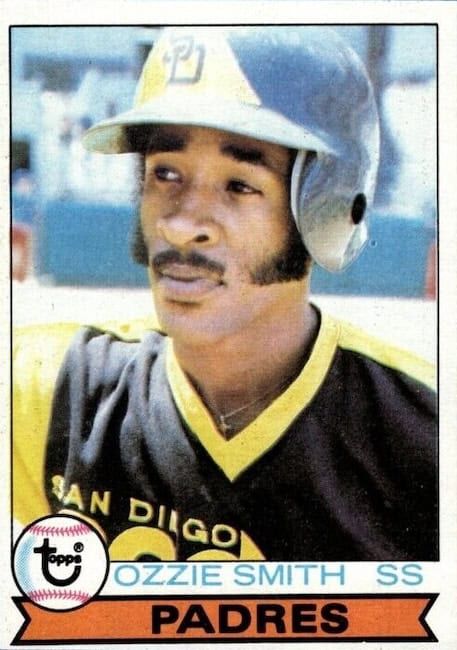
Player History
Ozzie Smith, known as “The Wizard,” was one of the greatest defensive shortstops in baseball history. He spent his entire career exclusively at shortstop, never playing a single inning at any other position. Over his 19-year career, primarily with the St. Louis Cardinals, Smith redefined the position with his acrobatic plays, unmatched range, and incredible glove work. He finished his career with an MLB-record 13 Gold Glove Awards at shortstop, a testament to his defensive dominance.
Smith’s career stats include 2,460 hits, 793 stolen bases, and a .262 batting average. While not known for his power—he hit just 28 career home runs—he excelled as a contact hitter and base stealer, twice leading the league in stolen bases among shortstops. His 1987 season, where he hit .303 and scored 104 runs, stands out as his best offensive campaign.
Smith’s fielding was where he truly left his mark. His ability to make difficult plays look routine and his flair for the spectacular helped earn him 15 All-Star selections. His playing style was defined by quick reflexes, strong fundamentals, and a deep understanding of positioning. This made him an irreplaceable part of the Cardinals’ defense during his tenure.
Smith’s contributions helped lead the Cardinals to three National League pennants and a World Series title in 1982. His leadership and work ethic were key factors in his team’s success. He was revered for his influence both on and off the field.
Ozzie Smith was inducted into the Baseball Hall of Fame in 2002.
Best baseball card: 1979 Topps Ozzie Smith #116 (RC)
“The Wizard’s” 1979 Topps rookie card is the cornerstone of 1970s collections. Featuring Smith as a Padre, it’s nearly impossible to find this card in gem-mint condition (only five PSA 10s exist), and it can command a huge premium. However, PSA 8 and below are more common, making it accessible to a wider range of collectors while still offering a connection to one of baseball’s greatest defensive shortstops.
Graded: $150-$400 (PSA 7-8)
Ungraded: $20-$25
7. Luke Appling

Player History
Luke Appling, known as “Old Aches and Pains,” was one of the most consistent and durable shortstops of his era. Appling spent his entire 20-year career with the Chicago White Sox. He had a keen eye at the plate and his ability to hit for average. He finished his career with a .310 batting average, collecting 2,749 hits and 1,116 RBIs.
Appling was particularly noted for his extraordinary ability to foul off pitches, frustrating opposing pitchers by extending at-bats. This skill helped him win two batting titles, in 1936 and 1943, when he hit .388 and .328, respectively. His .388 average in 1936 remains one of the highest single-season marks ever for a shortstop.
Defensively, Appling was a solid shortstop, known more for his reliability and strong arm than for flashy plays. While he wasn’t the most agile or quick, his instincts and knowledge of the game made him a valuable asset in the field. Over the course of his career, he earned seven All-Star selections and established himself as one of the best all-around shortstops of his generation.
Appling’s longevity and ability to remain productive late into his career were also remarkable. He played until 1950, well into his 40s, continuing to perform at a high level. His consistent hitting and leadership on the field were crucial to the White Sox, though the team never reached the postseason during his tenure.
Luke Appling was inducted into the Baseball Hall of Fame in 1964.
Best baseball card: 1948 Leaf Lucius “Luke” Appling #59
The 1948 Leaf Luke Appling #59 card captures a Hall of Fame shortstop in the twilight of his career. As one of the earliest post-war sets, the 1948 Leaf set is notorious for its bold colors, rough centering, and printing flaws, which only add to the charm and challenge of collecting. This card stands as a tribute to a gritty, consistent player whose career spanned both the dead-ball and modern eras.
Graded: $250-$300 (PSA 6-7)
Ungraded: $100-$150
6. Derek Jeter
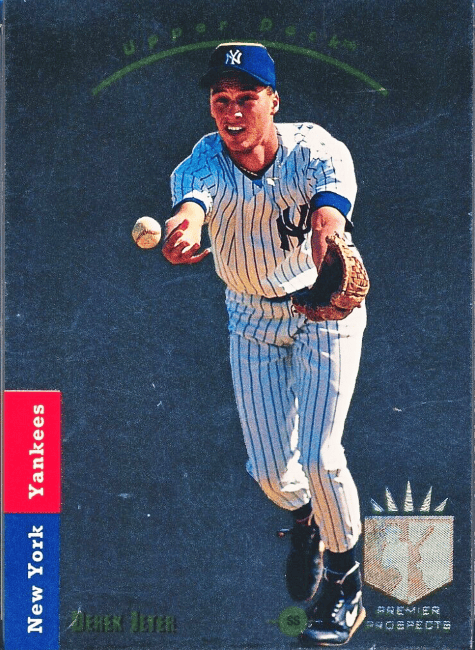
Player History
Derek Jeter, known as “The Captain,” is one of the most iconic shortstops in baseball history. Spending his entire 20-year career with the New York Yankees, Jeter became known for his clutch performances, leadership, and consistency. He finished his career with 3,465 hits, ranking sixth all-time, while posting a .310 batting average, 260 home runs, and 1,311 RBIs.
Jeter was a cornerstone of the Yankees’ dynasty of the late 1990s and early 2000s. He helped the team win five World Series championships. His ability to rise to the occasion in crucial moments, particularly in the postseason, earned him the nickname “Captain Clutch.” He holds numerous playoff records, including most hits (200) and runs scored (111) in postseason history.
Fans and pundits often debated Jeter’s defensive metrics. However, his trademark jump throws and steady presence at shortstop earned him five Gold Glove Awards. His fielding style emphasized reliability and intelligence, often positioning himself perfectly to make key plays. Jeter was also known as a leader on and off the field. He served in the rare role as the Yankees’ captain from 2003 until his retirement in 2014.
Jeter’s accolades also include 14 All-Star selections and five Silver Slugger Awards. His work ethic, professionalism, and impact on the game extended beyond his statistics, making him a fan favorite and a respected figure throughout baseball. He later became CEO and part owner of the Miami Marlins.
Derek Jeter was inducted into the Baseball Hall of Fame in 2020.
Best baseball card: 1993 Upper Deck SP Derek Jeter #279 (RC)
Featuring a young Jeter in a clean, action shot and printed on premium foil stock, the card set a new standard for high-end rookies in the ’90s. Its condition sensitivity – especially chipping along the edges – makes high-grade copies tough to find. As Jeter’s Hall of Fame legacy grew, this card became the definitive rookie for one of the most celebrated Yankees of all time.
Graded: $150-$300 (PSA 7-8)
Ungraded: $100-$150
5. Robin Yount
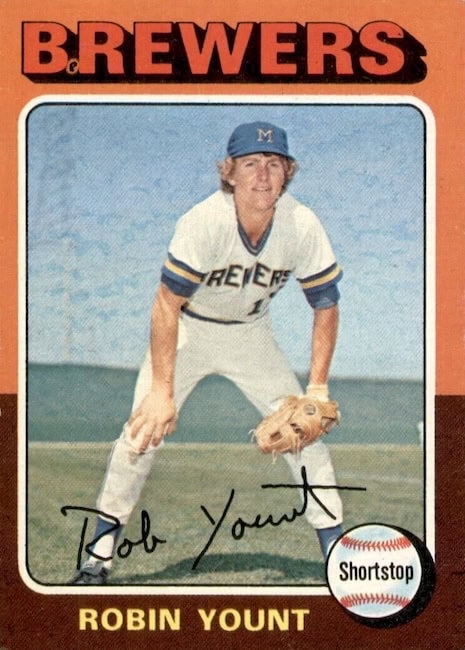
Player History
Robin Yount was a rare talent who excelled at both shortstop and center field during his 20-year career with the Milwaukee Brewers. Beginning his career as a shortstop, Yount quickly established himself as one of the best all-around players at the position. He blended strong defense with impressive offensive production.
Yount’s career stats include 3,142 hits, 251 home runs, 1,406 RBIs, and a .285 batting average. He won two MVP awards, the first in 1982 while playing shortstop, when he hit .331 with 29 home runs and 114 RBIs. He also helped lead the Brewers to the World Series.
Robin Yount was known for his athleticism, range, and strong arm. Though he eventually moved to the outfield, his time at shortstop was marked by consistency and leadership. He earned three All-Star selections and a Gold Glove Award in 1982 for his defensive prowess.
Yount’s ability to excel in multiple roles set him apart from many of his contemporaries. He is one of the few players in history to win MVP awards at two different positions, a testament to his adaptability and skill.
Robin Yount was inducted into the Baseball Hall of Fame in 1999.
Best baseball card: 1975 Topps Robin Yount #223 (RC)
Featuring a teenage Robin Yount just beginning his 20-year Hall of Fame career with the Milwaukee Brewers, the 1975 Topps #223 card features a bold design. Its age and centering issues make high-grade examples harder to find, adding to its appeal. As one of the standout rookies from a loaded 1975 Topps set, the Yount rookie remains a cornerstone for vintage collectors.
Graded: $150 (PSA 7)
Ungraded: $20-$30
4. Arky Vaughan
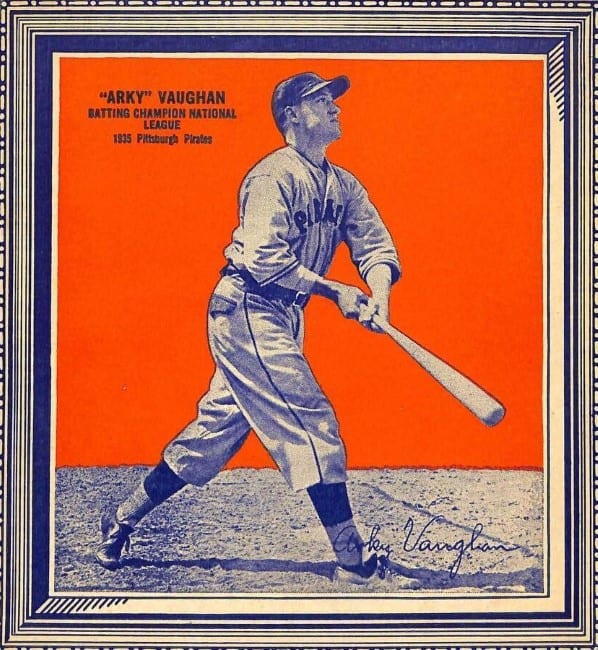
Player History
Arky Vaughan was one of the premier shortstops of the 1930s and 1940s, known for his exceptional hitting ability and steady defense. Over his 14-year career, primarily with the Pittsburgh Pirates and later with the Brooklyn Dodgers, Vaughan posted impressive offensive numbers that set him apart from many shortstops of his era.
Vaughan finished his career with a .318 batting average, 2,103 hits, 96 home runs, and 926 RBIs. His best season came in 1935 when he hit .385, one of the highest single-season averages ever for a shortstop, while also leading the league in on-base percentage (.491). Vaughan was a consistent hitter, finishing with a .300+ average in nine different seasons. He also drew a high number of walks, reflecting his excellent plate discipline.
Defensively, Vaughan proved dependable, with good range and a reliable glove. He didn’t make many spectacular plays, but his consistency at shortstop made him an asset. He earned nine All-Star selections and gained widespread recognition as one of the top players at his position during his career.
Vaughan also became known for his calm and steady demeanor. He avoided the spotlight but contributed in all aspects of the game, making him a valuable player both offensively and defensively.
Arky Vaughan was inducted into the Baseball Hall of Fame in 1985, long after his retirement, but his legacy as one of the best shortstops of all time remains secure.
Best baseball card: 1936 Wheaties Series 3 Arky Vaughan
The 1936 Wheaties Series 3 Arky Vaughan card is a rare and underrated gem from the early days of cereal-box collectibles. Unlike traditional card sets of the time, Wheaties cards were hand-cut from the back of cereal boxes, making well-preserved examples particularly scarce.
Graded: No data
Ungraded: $100-$150
3. Cal Ripken Jr.

Player History
“The Iron Man,” Cal Ripken Jr., is one of the most celebrated shortstops in baseball history. Playing his entire 21-year career with the Baltimore Orioles, Ripken became synonymous with durability and consistency, famously breaking Lou Gehrig’s record for consecutive games played with 2,632 games, a feat that showcased his resilience and dedication to the game.
Ripken’s career stats are impressive: he recorded 3,184 hits, 431 home runs, and 1,695 RBIs, finishing his career with a .276 batting average. His power and offensive production set him apart from many of his contemporaries at shortstop, as he often contributed both with his bat and his glove. Ripken won two American League MVP awards, in 1983 and 1991, with his 1983 season being particularly noteworthy as he helped lead the Orioles to a World Series championship.
Defensively, Ripken was equally proficient. He earned two Gold Glove Awards, demonstrating his skill at shortstop. His range, strong arm, and intelligence on the field made him a formidable presence, and he was known for his ability to turn double plays with efficiency.
Ripken’s influence extended beyond the diamond; he became a role model for aspiring athletes, exemplifying sportsmanship and professionalism. His work ethic and commitment to the game inspired many, earning him the respect of fans and players alike.
Cal Ripken Jr. was inducted into the Baseball Hall of Fame in 2007.
Best baseball card: 1982 Topps Traded Cal Ripken Jr. #98T (RC)
This is Ripken’s first solo rookie card, and it’s so iconic that it got remixed as part of Topps Project 2020, where artists reimagined classic cards from the hobby’s history. Unlike the 1982 Topps base card, which features Ripken alongside two other players, the Traded version spotlights him alone, making it one of the most sought after cards of the 1980s.
Graded: $150-$450 (PSA 7-9)
Ungraded: $50-$100
2. Alex Rodriguez

Player History
Alex Rodriguez is one of the most accomplished players in baseball history, renowned for his exceptional talent as both a shortstop and a third baseman. Over his 22-year career, Rodriguez showcased a rare combination of power, speed, and defensive ability, solidifying his place among the game’s greats.
Fans love to hate A-Rod, but he was one of several players who redefined the shortstop position in the 1990s and 2000s. Rodriguez began his career with the Seattle Mariners in 1994, where he quickly emerged as a rising star. He later signed with the Texas Rangers, becoming the highest-paid player in sports history at the time. He eventually joined the New York Yankees, where he won a World Series title in 2009. A-Rod’s career stats are impressive: he amassed 3,115 hits, 696 home runs, and 2,086 RBIs, finishing with a .295 batting average. He ranks fourth on the all-time home run list and is one of only a handful of players to surpass 3,000 hits.
Defensively, Rodriguez was a skilled shortstop early in his career, earning two Gold Glove Awards. His strong arm and quick reflexes made him a standout at the position. However, after his trade to the Yankees, he transitioned to third base to accommodate Derek Jeter, where he continued to excel.
A-Rod won three American League MVP awards during his career, showcasing his elite offensive capabilities. He was a 14-time All-Star and earned numerous Silver Slugger Awards, reflecting his prowess as a hitter.
Despite his on-field accomplishments, Rodriguez’s career has been marred by controversies surrounding performance-enhancing drugs. This led to a suspension in 2014. This aspect of his career has sparked debates about his legacy and has kept him from being elected into the National Baseball Hall of Fame.
Best baseball card: 1994 Upper Deck SP Alex Rodriguez #15 (RC)
Printed on foil with a premium design, the 1994 SP Rodriguez rookie card stood out at the time for its high-end look and limited availability compared to traditional base cards. Featuring a young A-Rod in his Mariners uniform, this card captures the beginning of a career that would include over 600 home runs and multiple MVP awards. Condition sensitivity – especially chipping on the foil edges – has made high-grade copies especially valuable.
Graded: $150 (PSA 9)
Ungraded: $25-$50
1. Honus Wagner
Player History
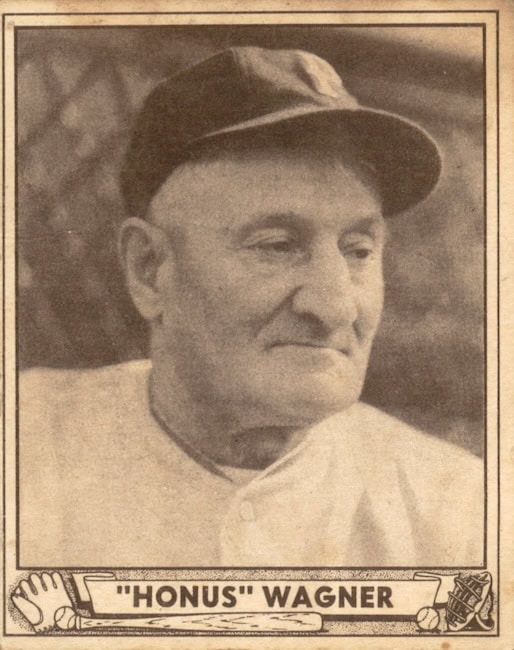
Honus Wagner, often regarded as one of the greatest shortstops in baseball history, played a significant role in defining the position during the early 20th century. Spending 18 seasons with the Pittsburgh Pirates, Wagner’s combination of defensive prowess and offensive skills set a high standard for future generations of shortstops.
Wagner finished his career with an impressive .328 batting average, 3,420 hits, 101 home runs, and 1,732 RBIs. He was a formidable hitter, leading the National League in batting average eight times and in stolen bases for several seasons, showcasing his speed and base-running intelligence. His best offensive season came in 1908, when he hit .354 with 191 hits, 100 runs scored, and 67 stolen bases.
Defensively, Wagner was equally remarkable. Known for his exceptional range and strong arm, he revolutionized the shortstop position with his ability to field ground balls and make accurate throws. Wagner’s leadership and work ethic made him a natural on-field captain, earning him the respect of teammates and opponents alike.
He was selected to the Hall of Fame in 1936 as one of its inaugural members.
Best baseball card: 1909-1911 T206 Honus Wagner
Whenever Honus Wagner appears on one of our lists, his best baseball card is the worst kept secret. The T206 Honus Wagner has so much intrigue that it’s referred to as the “Holy Grail” of baseball card collecting. Not only is Wagner the best shortstop ever, he has the best card ever.
Graded: $7,000,000-$9,000,0000 (PSA 6-8)
Ungraded: $2,000,000-$3,000,000
Honorable mention: 1940 Play Ball Honus Wagner #168
If spending a couple of million dollars on a card is out of your price range, consider the 1940 Play Ball Honus Wagner #168. It’s not from his playing days, but it’s a nice shot of Wagner during his time as the manager of the Pittsburgh Pirates. The 1940 Play Ball set is iconic and this is a very worthy card for any price-sensitive early baseball card collectors.
Graded: $1,200-$3,600 (PSA 8)
Ungraded: $200-$500

